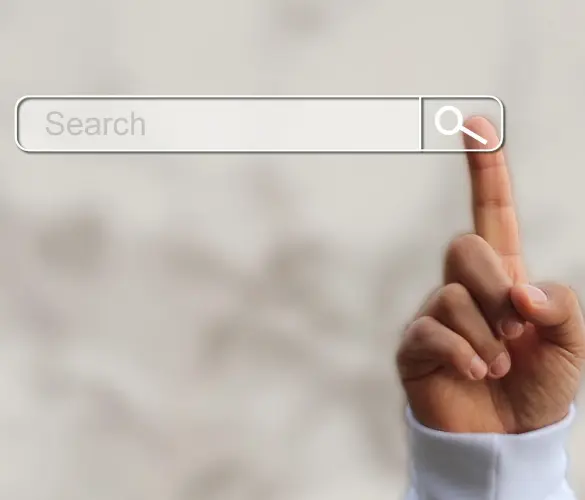- Blogs
- WordPress 101
- How to Access the WordPress Admin With a Fatal Error Warning
WordPress 101 / 11 min read
How to Access the WordPress Admin With a Fatal Error Warning
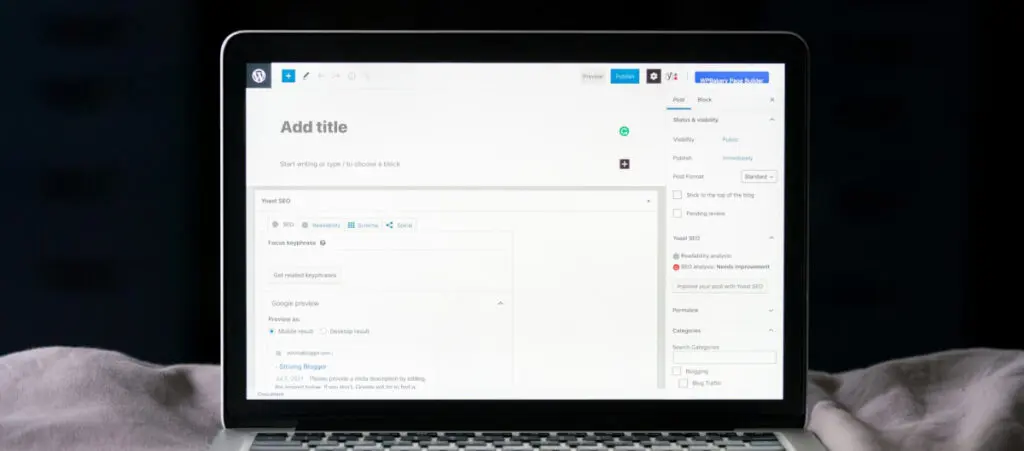
A fatal error warning is a frustrating issue that prevents access to the WordPress admin, effectively locking you out of your own site indefinitely. But don’t despair because there is a reliable way to gain access to your WordPress admin after a fatal error: Recovery Mode.
Let’s find out what fatal errors are and how Recovery Mode helps you bypass and solve them.
Key Takeaways
- The most reliable way to access your WordPress admin after a fatal error is Recovery Mode.
- Recovery Mode is a built-in feature that allows you to bypass problems that prevent you from accessing your admin.
- You can access Recovery Mode from a link that WordPress will automatically email you or by manually inputting the Recovery Mode URL into your browser.
What Are WordPress Fatal Errors?
WordPress fatal errors happen when a fatal PHP error occurs, preventing your site from loading the scripts it needs to run properly. As you may know, PHP is the programming language WordPress is primarily written in and the one developers use to create custom functions.
When a fatal PHP error occurs, the scripts your site needs to function cannot be loaded and your site crashes. These scripts may be associated with your WordPress core files, themes, or plugins.
After a fatal error, you may see a critical error screen when you try to log into your site or a message similar to the following:
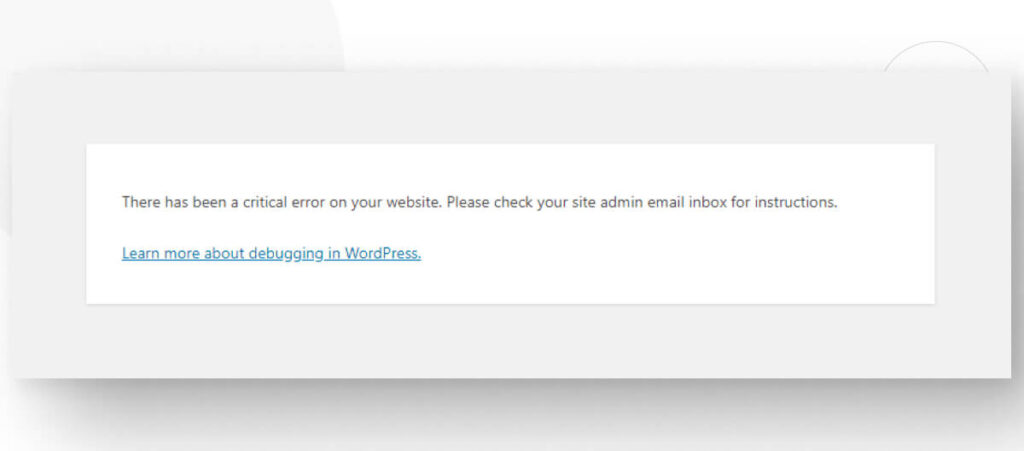
You may think there’s no solution, but there actually is a feature specifically designed to provide access to your WordPress admin after problems like this: Recovery Mode.
What is Recovery Mode and How Does it Help Access the WordPress Admin?
Recovery Mode is a built-in feature of WordPress since version 5.2 (2019). Since this version, WordPress automatically detects when a theme or plugin causes a fatal error on your site and sends a message to the administrator’s email address informing them of the situation.
The email message contains a link to access your site in Recovery Mode.
However, depending on the error screen you see, you may receive an email message. Still, there is a way to manually access Recovery Mode in cases where you don’t receive the email message. We’ll explore these methods further down.
Ultimately, recovery Mode allows you to access your admin dashboard and gives you the opportunity to solve whatever is causing the problem. For example, your site may be broken due to plugin and theme compatibility issues.
With Recovery Mode, you have a chance to bring your site back up.
2 Methods to Access Your WordPress Admin With a Fatal Error Warning
Now that we know what the fatal error is and how to bypass it to access your WordPress admin, let’s go into the step-by-step process of bringing your site up.
Method #1: Access WordPress Recovery Mode Via the Email Link
After detecting a fatal error with one of your themes or plugins, WordPress sends a message to the site administrator’s email address. If this is your site, you should have access to this email.
If you don’t own this site and have no access to the admin email, ask the administrator to either grant you access or follow along on the process. Alternatively, if you’ve lost access to the admin email, you can use method #2 in this article to access Recovery Mode.
Let’s get into the process.
Step #1: Access the Email
Assuming you have access to the admin’s email account, WordPress will send you an email with a link to access your site in Recovery Mode. The subject will be “Your Site Is Experiencing a Technical Issue,” and the content will give you some information about Recovery Mode.
Click on the link to access your WordPress site in Recovery Mode.
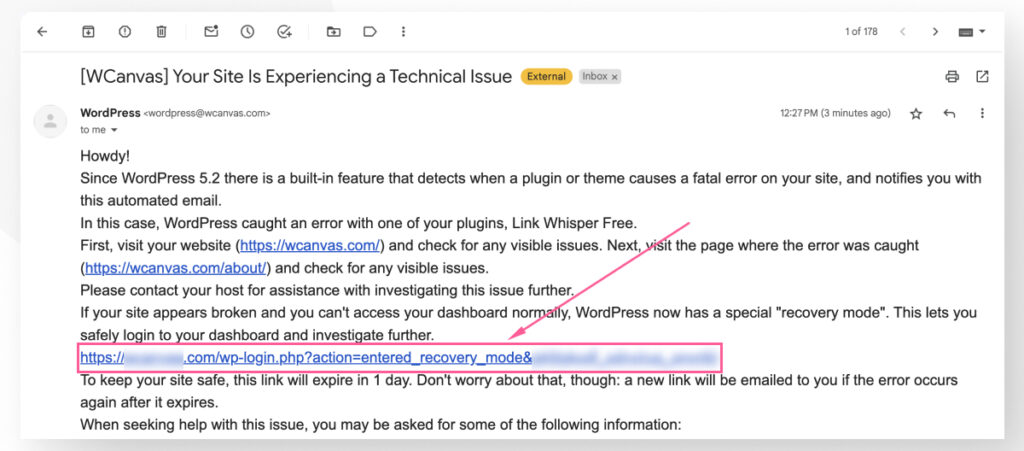
Step #2: Log in
The link will take you to your login screen. Notice the message clarifying that you’re in Recovery Mode.
Simply log in as you normally would.
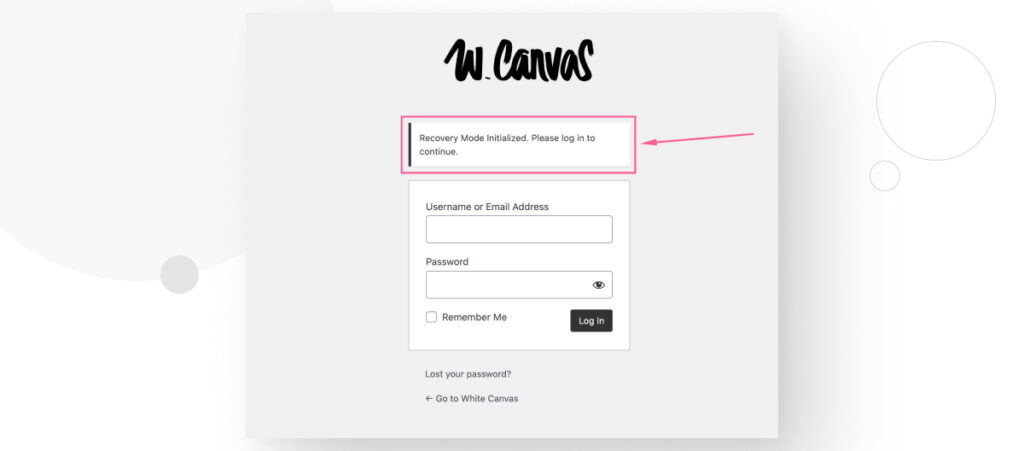
Now you’re back in your familiar admin dashboard, and you can start troubleshooting the problem.
We’ll explore possible solutions to your problem further down in the article. But for now, let’s examine the alternative method for accessing your site in Recovery Mode.
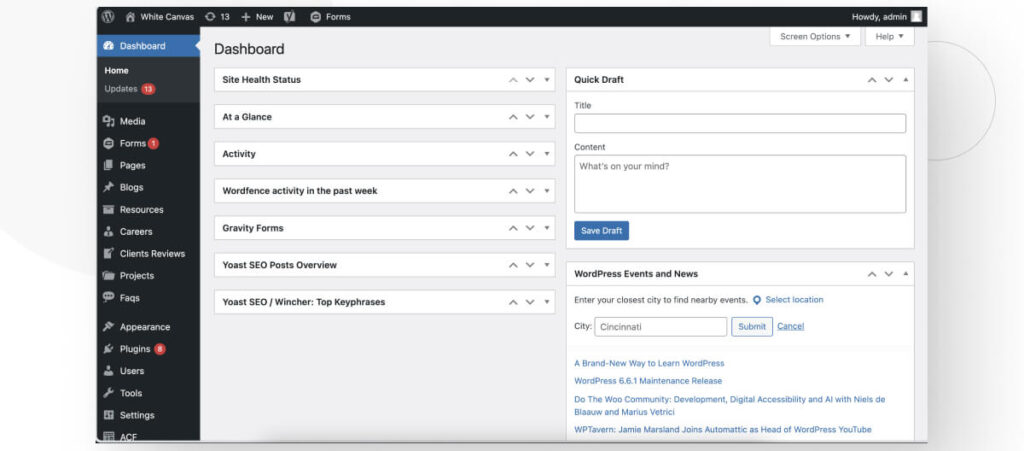
Method #2: Access WordPress Recovery Mode By Using the Recovery URL
In some cases, you may get a fatal error screen that prevents access to the WordPress admin dashboard, but you still don’t get the WordPress email giving you access to Recovery Mode.
It could be because you no longer have access to the admin email address or for various other reasons.
In any case, you can access Recovery Mode manually by entering the Recovery Mode URL address into your browser’s address bar. The Recovery Mode URL address is as follows:
your-domain.com/wp-login.php?action=entered_recovery_modeSimply input this URL in your browser’s address bar (remember to change your-domain into your actual domain):
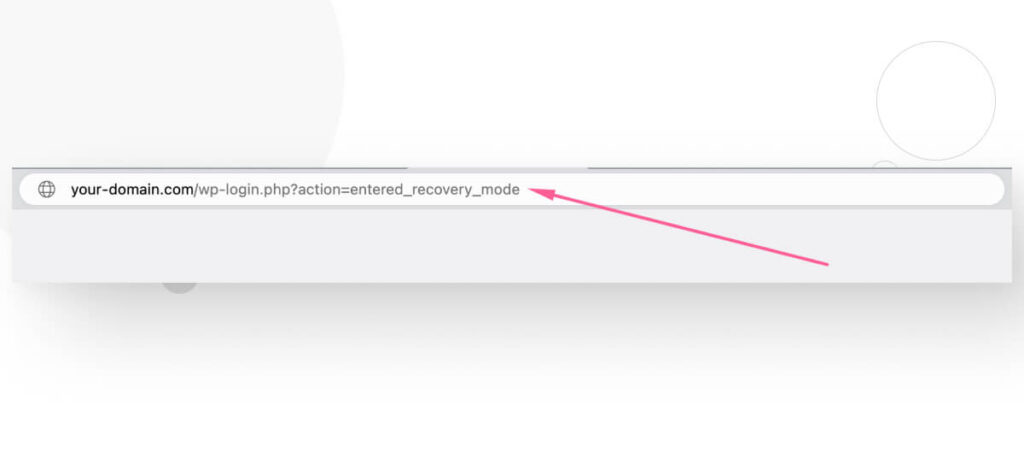
You will land at the familiar login screen, where you can enter your credentials and access your admin dashboard in Recovery Mode.
From there, you can start troubleshooting the problem.
How to Recover Your Site After a Fatal Error: 5 Solutions
After gaining access to your WordPress admin with Recovery Mode, you still need to resolve whatever caused the issue in the first place to bring your site back up, as it will still be down.
Let’s explore 5 solutions to a fatal error that can restore your site to normal functioning.
Solution #1: Restore a Previous Backup in Recovery Mode
Backing up your site is essential for disaster recovery situations like this. Hopefully, you have a backup plugin that creates regular backups, and you can restore one of them.
We’ve used the UpdraftPlus plugin, and it’s very reliable. In this example, we’ll restore a backup with this plugin. Other plugins will have similar but probably slightly different steps.
How to Restore a Backup
Assuming you already have a backup, here’s how to restore it with UpdraftPlus. On your website’s dashboard, go to Settings > UpdraftPlus Backups.
In the section Existing backups, you’ll have a list of backups UpdraftPlus has created. Each backup will have a Restore button to restore that specific backup. Select the backup you want to restore and click Restore.
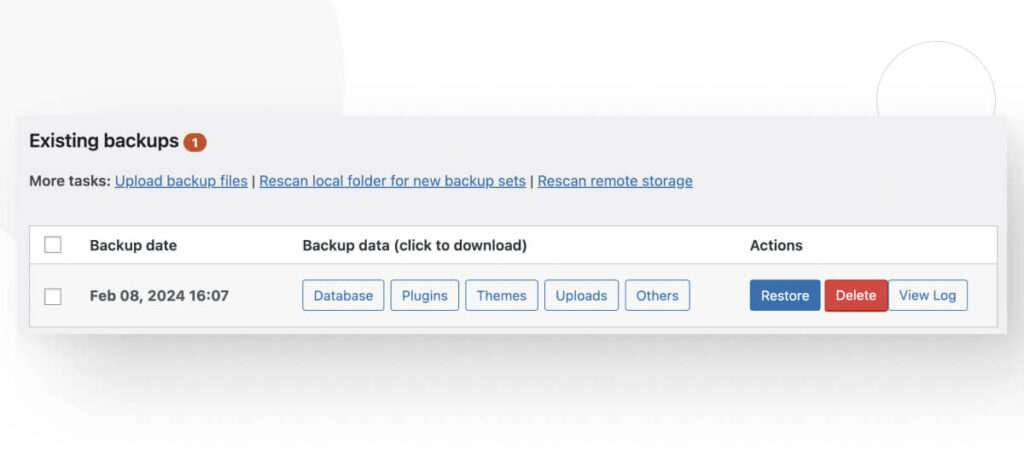
Now, you’ll be given the option to restore specific file types: Plugins, Themes, Uploads, Other, and Database. Check every type to perform a full restore, then click Next.
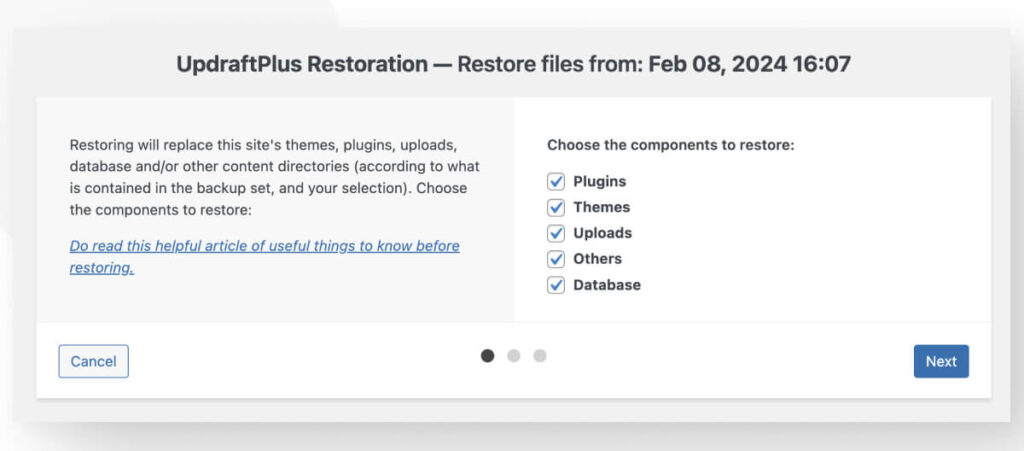
On the following screen, click Restore, and the process will begin.
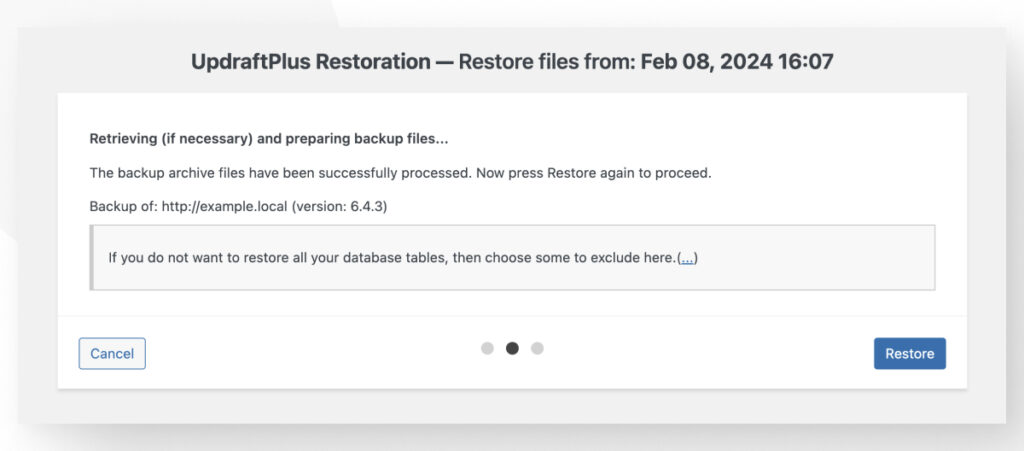
Wait for the restoration to complete. You’ll get a “Restore successful” message at the end. Finally, click on Return to UpdraftPlus configuration to finish the process.
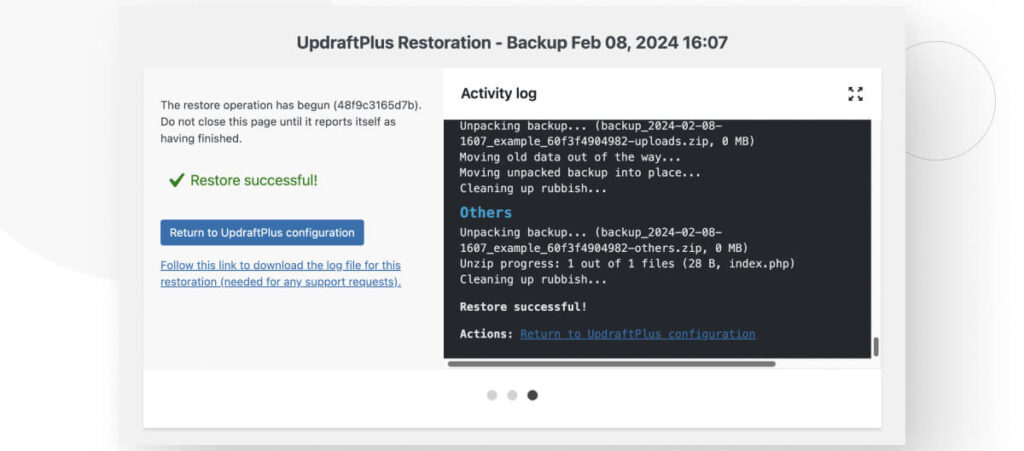
Always create backups before installing or updating your plugins, themes, or WordPress versions. This gives you a recent checkpoint to go back to when emergencies like fatal errors happen.
Solution #2: Deactivate the Offending Plugin or Theme
If you received WordPress’s email on the admin account, the message should identify the plugin or theme that caused the problem in the following line:
In this case, WordPress caught an error with one of your plugins, [plugin name].
With that plugin or theme in mind, access Recovery Mode through the email or manual URL and deactivate it.
Option #1: Deactivate a Plugin
If WordPress identified a plugin as the root of the issue, the first step should be deactivating it. In our case, the email mentioned the Link Whisper Free plugin. So, let’s head to Plugin > Installed Plugins and deactivate it.
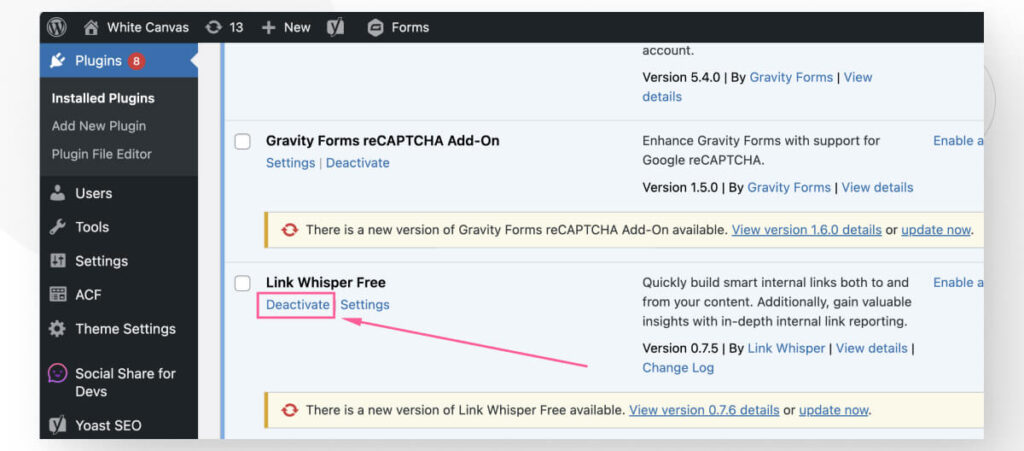
After deactivating the plugin, check back with your live site to see if it’s working again. If it is, then your site should be back on track.
However, if you plan to continue using your plugin or theme, you still need to determine the issue. To do this, you should create a staging or local environment and start troubleshooting.
Alternatively, you could contact the developer through the plugin’s WordPress.org page.
If you can’t figure out the problem and the developer isn’t able to provide support, you may need to look for a new plugin.
Option #2: Switch to a Default Theme
If the problem is instead a theme, then you should go to Appearance > Themes and switch to a default theme like Twenty Twenty-Four, Twenty Twenty-Three, etc.
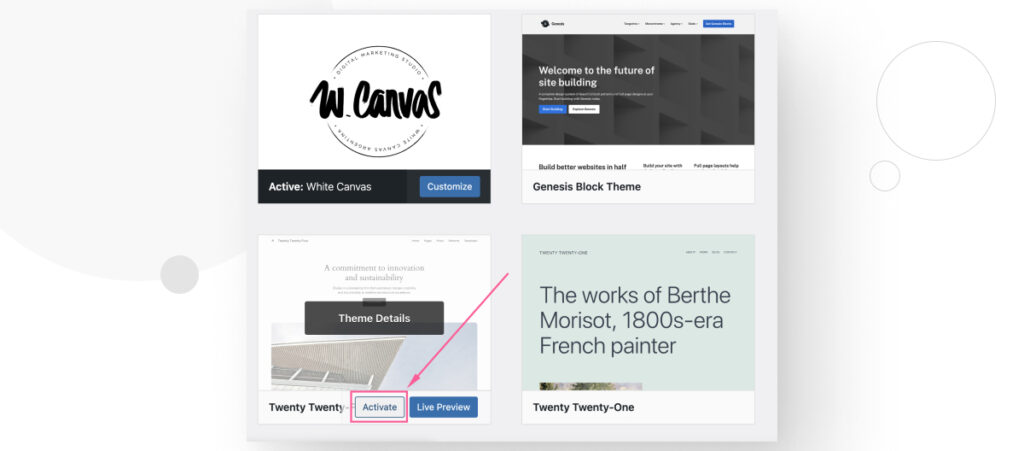
If your live site comes back up after switching to a default theme, that’s great, but you probably also want to keep using your theme.
Do the same as you would for a plugin: start troubleshooting or contact the theme developer for help.
What if the Email Doesn’t Specify a Plugin or Theme?
If the email with the link to Recovery Mode doesn’t specify a plugin or theme, you should deactivate all plugins and activate them one at a time to see if your live site comes back up. At some point, you will find the one breaking your site.
To do that, scroll to the top of the Installed plugins page and click the checkbox to select all plugins.
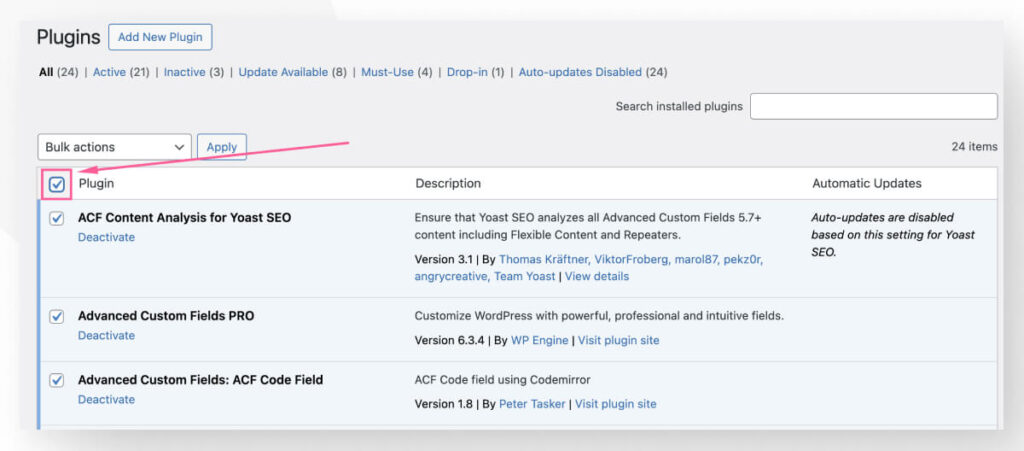
Then, select Deactivate from the Bulk Actions dropdown menu.
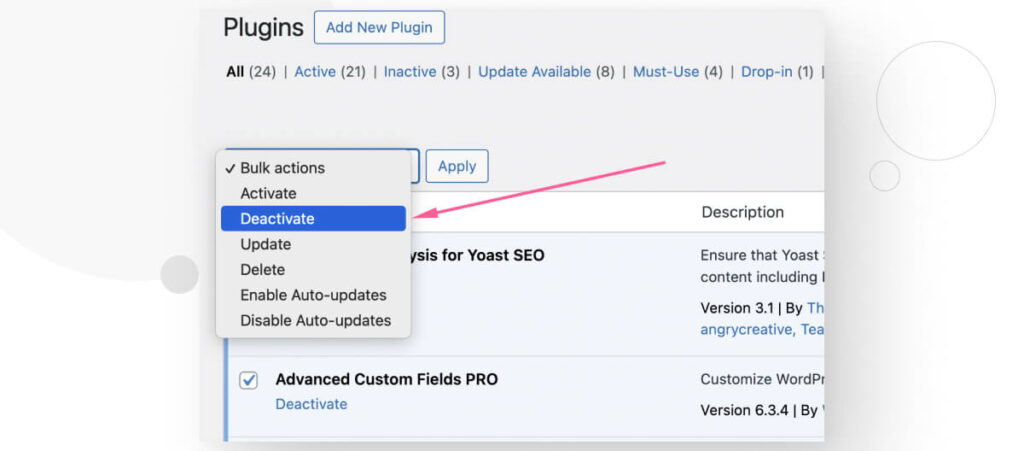
Start activating each plugin individually and check back with your live site every time.
If you believe the problem is a theme instead of a plugin, go to Appearance > Themes and switch to a default theme like Twenty Twenty-Four.
Solution #3: Reupload Core WordPress Files
If you believe there’s a problem with the core files, reuploading them should wipe out the conflict and bring your site back up. Let’s explore how to reupload files automatically from your dashboard or, alternatively, manually through an FTP client.
How to Reupload Files Quickly From the Dashboard
The quickest and easiest way to reupload core WordPress files into your installation is to access your site in Recovery Mode, go to Dashboard > Updates, and click on Reinstall version X.X.X.
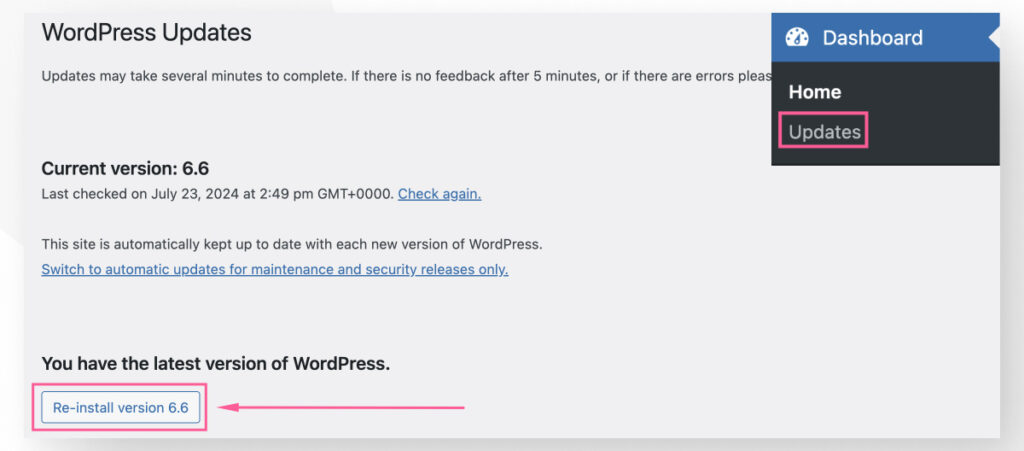
It may take a few seconds, but you will land on your version’s About page when it’s done.
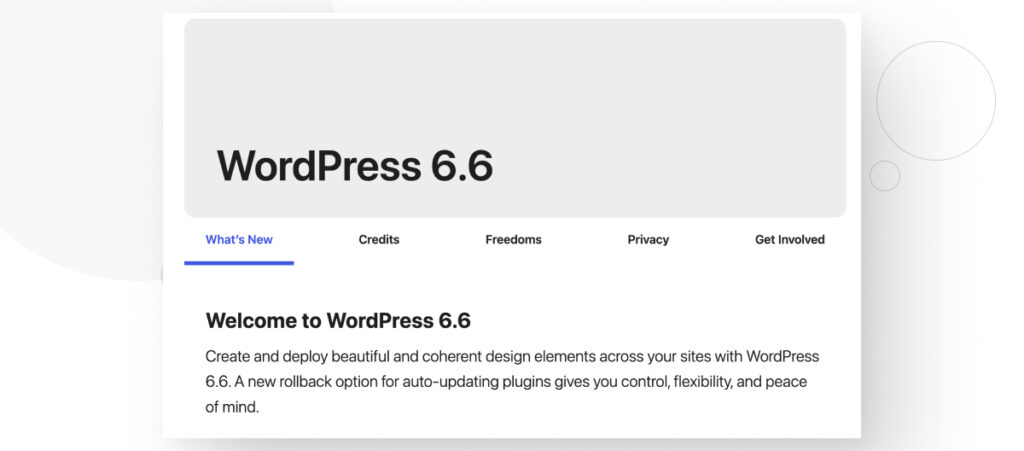
How to Reupload Files Manually Using an FTP Client
The manual alternative if you can’t access your admin dashboard is manually uploading files via FTP.
First, go to WordPress.org’s Download page and download the latest version of WordPress.
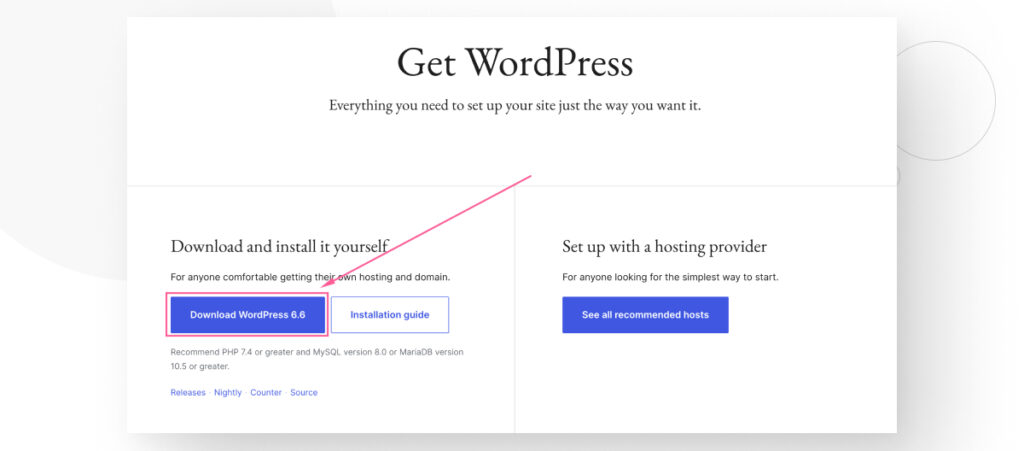
WordPress will download as an archive, so use 7zip or WinRAR to unzip the archive and reveal the core files inside.
With the core files unzipped, enter your FTP credentials and connect to your web server. Navigate to your server’s public_html folder (sometimes named simply public).
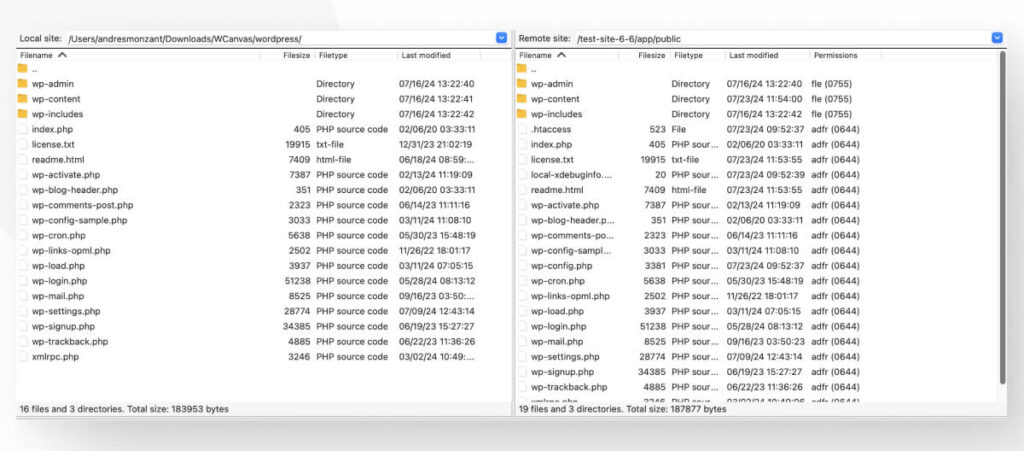
Now, you must select every folder and file (except for wp-content) on the WordPress installation you just downloaded and drag them into your web server.
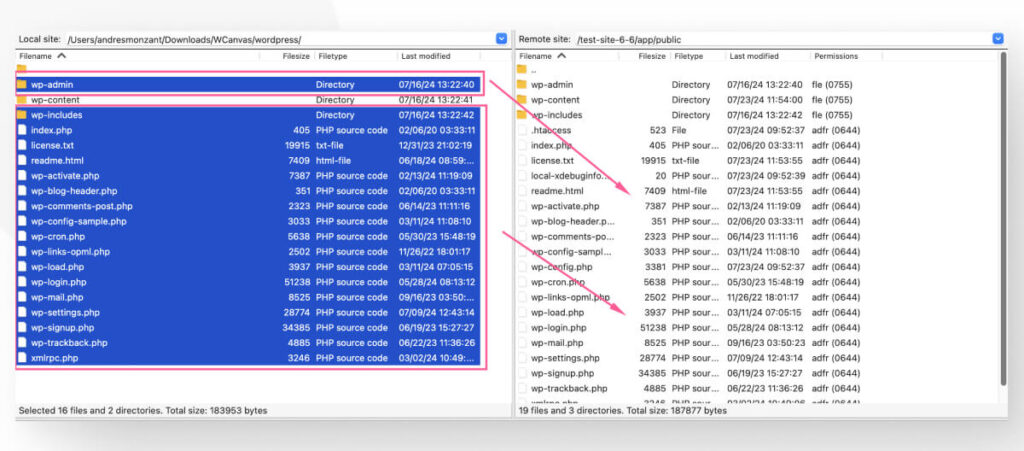
And with that, your core files will be overwritten, potentially wiping out any issues they may have that were causing the critical error.
Solution #4: Increase Your PHP Memory Limit
If your WordPress site has multiple plugins that demand a lot of memory, your site may crash and return a fatal error screen.
A low PHP memory limit is a common problem in relatively cheap hosting providers, which often offer limited resources. To increase it, you’ll have to modify one line from the wp-config.php file.
To access the file, use a hosting control panel like cPanel or FileZilla. Navigate to the public_html folder, then right-click wp-config.php, and select View/Edit.
Once inside the file, use CTRL + F or CMD + F to search for WP_MEMORY_LIMIT. If you find it, it’ll look like this:
define('WP_MEMORY_LIMIT', '64M');Simply change 64M to 128M or 256M to increase your PHP memory limit. 128M should be enough for most sites, and 256M should be enough for sites that run resource-intensive plugins.
If you can’t find the line, you’ll simply have to copy and paste it. You must insert it above the line that says /* That's all, stop editing! Happy publishing. */, which is near the end of the file. It should look like this:
define('WP_MEMORY_LIMIT', '256M');
/* That's all, stop editing! Happy publishing. */Solution #5: Contact Your Hosting Provider
If you’ve tried several solutions and can’t seem to figure out what’s wrong or how to solve it, it may help to contact your hosting provider. They may have experience with this issue and take the appropriate steps to solve it.
Additionally, some hosting providers have restrictions that prevent you from making changes, such as increasing your PHP memory limit, especially if you’re using a shared hosting plan, which usually has more limited resources.
Contacting your web host and explaining the problem may get them to scan your site and look for potential solutions.
Access Your WordPress Admin Dashboard Again With Recovery Mode
Fatal errors can prevent you from accessing your WordPress admin dashboard and lock you out of your own site. The best way to access your admin dashboard after a fatal error is Recovery Mode, a built-in feature that allows you to bypass issues like plugin and theme incompatibilities to restore your site to its normal functionality.
We explored 2 methods for accessing your WordPress admin through Recovery Mode and 5 solutions to the fatal error. Hopefully, one of them will help you bring your site back to normal.
If you found this post useful, read our blog and resources for more insights and guides!
Related Articles
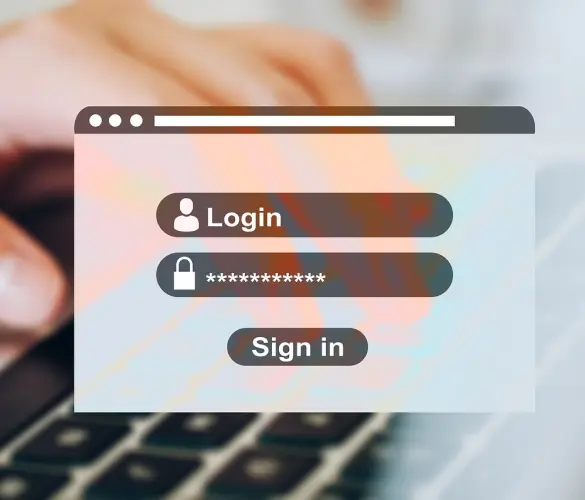
How to... / 5 min read
How to... / 5 min read
How to Make a Subscriber Into an Admin on WordPress?
While it's not the most common situation, at some point, you may find yourself needing to make a Subscriber into an Admin on your WordPress site. Maybe you need to…
Read More
How to... / 3 min read
How to... / 3 min read
How to Grant Secure Access to a Not Live WordPress Site During Development
When developing a WordPress site, you often need to collaborate with multiple developers and grant access to the website owner so they can review the progress themselves. However, granting access…
Read More
Industry Insights / 11 min read
Industry Insights / 11 min read
Do You Need a Web Developer to Build a WordPress Site?
If you’re building a WordPress site or considering building one, you wonder whether you need a web developer to create it or you can do it yourself. The answer can…
Read More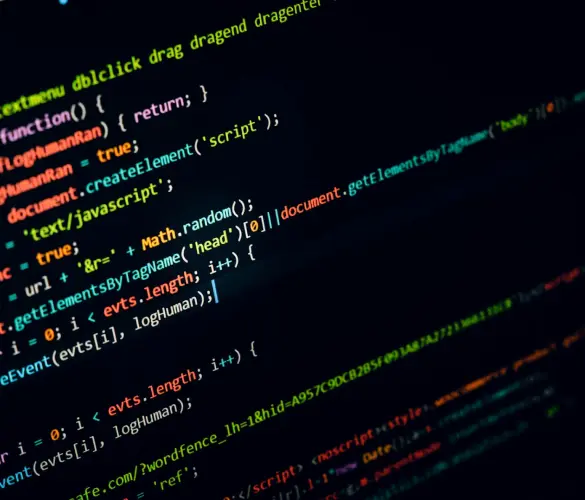
How to... / 6 min read
How to... / 6 min read
How to Change the Bottom Padding Dimensions on WordPress Blocks
If you're learning to modify your WordPress site's layouts and design, you may be wondering how to change the bottom padding dimensions of some of its elements. If that's the…
Read More
How to... / 10 min read
How to... / 10 min read
How to Disable the “Similar Posts” Section in WordPress Blogs
If you’re diving deeper into customizing your site, you may be wondering how to disable the “Similar Posts” section that appears on the bottom, sidebar, or footer of your WordPress…
Read More